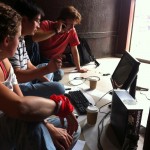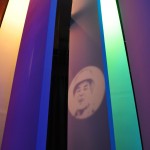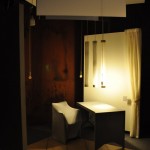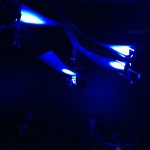Original article from OpenLight.nl, by Rombout Frieling, creative director OPENLIGHT and project initiator, Light Through Culture.
LIGHT THROUGH CULTURE

During the past two weeks, 14 young designers from the Netherlands and China worked together intensively in a masterclass led by the OPENLIGHT creative light laboratory.
For two days, the team lived with Beijing’s cleaners, bus drivers, parents and school kids.
They turned their insights from Beijing Culture into three lighting concepts, which we show here in three cylinders. The purpose is a dialogue about how smart lighting can contribute to a healthy city.
The presented installations are realised by technologies such as intelligent systems and LEDs, which reveal new design opportunities.
At OPENLIGHT, the creative lab of the Intelligent Lighting Institute (ILI, Eindhoven, the Netherlands), we explore for instance how light can help us focus, reflect, regulate our biorhythms, improve safety or escape from hectic everyday life.
OPENLIGHT initiated ‘Light through Culture’ to respond to cultural challenges in various cities, such as here in Beijing with Tsinghua University. We present the results for you in three cylinders:
LOST IN BEIJING

Xiaohua is one of the 2 million urbanites without a Beijing ID. Six years ago he left his hometown and family, to earn money. Non stop work, no time to live a life beside his work.
He helps to shape a city that is anonymous to him. He feels lost in a city that is not his own. Soon, he will have to return to the region where he belongs.
Did he only loose some years of his life in return for money?
We asked Beijing workers and understood their desire to leave a personal mark in the city. Could their unique identity bring a personal and human face to the city?
In this cylinder, we use light to give recognition to those who built Beijing with loyalty.
Could light help to recognise your location in a place that is anonymous to you?
WATTS MATTER

For Zhang and her family, energy matters. Many Beijing families have only one lamp in their house.
Zhang exactly knows that her light bulb only uses 12 Watts of energy: Saving watts means saving money. It means more money for the future of her child.
Saving (energy) is one of the common habits in Beijing.
At the same time, bright spaces have become a luxury to aspire to: “A lot of light is for the rich. Darkness is for the poor. A lot of light is beautiful”, Zhang says.
In this cylinder we show that Less is More could also apply to light: this installation never uses more than 12 watts at a time, no matter which switch you pull.
Can you find a lighting setting that saves energy and gives you a feeling of luxury at the same moment?
PEACE IN THE CROWD

Wener is 13 years. School is intense. Short eye exercises are one of the few possibilities to relax. Goal: be focussed again. Perform. Be the best student you can.
Mother Limin escapes everyday life by taking her car for a nightly drive around Beijing. Destination: inner peace.
Beijing is in a competitive mode. It is hard to find time for personal reflections and emotions.
We explore how the lighting in public transit spaces helps us to find inner peace in moments which are normally wasted. In the cylinder you experience natural movements. Imagine the attraction of a woodfire, or a shadow of a tree waving in the wind. Through light these natural movements are synchronised with the movement of a crowd of people.
How does it feel to achieve ‘inner peace in a crowd’? (ancient Chinese saying)
Slow down and you will be rewarded.